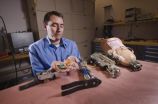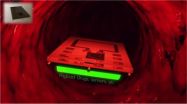(Press-News.org) ALBUQUERQUE, N.M — Sandia National Laboratories researchers, using off-the-shelf equipment in a chemistry lab, have been working on ways to improve amputees' control over prosthetics with direct help from their own nervous systems.
Organic materials chemist Shawn Dirk, robotics engineer Steve Buerger and others are creating biocompatible interface scaffolds. The goal is improved prosthetics with flexible nerve-to-nerve or nerve-to-muscle interfaces through which transected nerves can grow, putting small groups of nerve fibers in close contact to electrode sites connected to separate, implanted electronics.
Neural interfaces operate where the nervous system and an artificial device intersect. Interfaces can monitor nerve signals or provide inputs that let amputees control prosthetic devices by direct neural signals, the same way they would control parts of their own bodies.
Sandia's research focuses on biomaterials and peripheral nerves at the interface site. The idea is to match material properties to nerve fibers with flexible, conductive materials that are biocompatible so they can integrate with nerve bundles.
"There are a lot of knobs we can turn to get the material properties to match those of the nerves," Dirk said.
Buerger added, "If we can get the right material properties, we could create a healthy, long-lasting interface that will allow an amputee to control a robotic limb using their own nervous system for years, or even decades, without repeat surgeries."
Researchers are looking at flexible conducting electrode materials using thin evaporated metal or patterned multiwalled carbon nanotubes.
The work is in its early stages and it might be years before such materials reach the market. Studies must confirm they function as needed, then they would face a lengthy Food and Drug Administration approval process.
But the need is there. The Amputee Coalition estimates 2 million people in the United States are living with limb loss. The Congressional Research Service reports more than 1,600 amputations involving U.S. troops between 2001 and 2010, more than 1,400 of those associated with the fighting in Iraq and Afghanistan. Most were major limb amputations.
Before joining Sandia, Buerger worked with a research group at MIT developing biomedical robots, including prosthetics. Sandia's robotics group was developing prosthetics before his arrival as part of U.S. Department of Energy-sponsored humanitarian programs to reduce proliferation risks.
Robotics approached the problem from a technical point of view, looking at improving implantable and wearable neural interface electronics. However, Buerger said that didn't address the central issue of interfacing with nerves, so researchers turned to Dirk's team.
"This goes after the crux of the problem," he said.
The challenges are numerous. Interfaces must be structured so nerve fibers can grow through. They must be mechanically compatible so they don't harm the nervous system or surrounding tissues, and biocompatible to integrate with tissue and promote nerve fiber growth. They also must incorporate conductivity to allow electrode sites to connect with external circuitry, and electrical properties must be tuned to transmit neural signals.
Dirk presented a paper on potential neural interface materials at the winter meeting of the Materials Research Society, describing Sandia's work in collaboration with the University of New Mexico and MD Anderson Cancer Center in Houston. Co-authors are Buerger, UNM assistant professor Elizabeth Hedberg-Dirk, UNM graduate student and Sandia contractor Kirsten Cicotte, and MD Anderson's Patrick Lin and Gregory Reece.
The researchers began with a technique first patented in 1902 called electrospinning, which produces nonwoven fiber mats by applying a high-voltage field between the tip of a syringe filled with a polymer solution and a collection mat. Tip diameter and solution viscosity control fiber size.
Collaborating with UNM's Center for Biomedical Engineering and department of chemical engineering, Sandia researchers worked with polymers that are liquid at room temperature. Electrospinning these liquid polymers does not result in fiber formation, and the results are sort of like water pooling on a flat surface. To remedy the lack of fiber formation, they electrospun the material onto a heated plate, initiating a chemical reaction to crosslink the polymer fibers as they were formed, Dirk said.
Researchers were able to tune the conductivity of the final composite with the addition of multiwalled carbon nanotubes.
The team electrospun scaffolds with two types of material — PBF, or poly(butylene fumarate), a polymer developed at UNM and Sandia for tissue engineering, and PDMS, or poly(dimethylsiloxane).
PBF is a biocompatible material that's biodegradable so the porous scaffold would disintegrate, leaving the contacts behind. PDMS is a biocompatible caulk-like material that is not biodegradable, meaning the scaffold would remain. Electrodes on one side of the materials made them conductive.
Sandia's work was funded through a late-start Laboratory Directed Research & Development (LDRD) project in 2010; afterward the researchers partnered with MD Anderson for implant tests. Sandia and MD Anderson are seeking funding to continue the project, Dirk said.
Buerger said they're using their proof-of-concept work to obtain third-party funding "so we can bring this technology closer to something that will help our wounded warriors, amputees and victims of peripheral nerve injury."
Sandia and UNM have applied for a patent on the scaffold technique. Sandia also filed two separate provisional patent applications, one in partnership with MD Anderson and the other with UNM, and the partners expect to submit full applications this year.
The MD Anderson collaboration came about because then-Sandia employee Dick Fate, an MD Anderson patient who'd lost his left leg to cancer, thought the hospital and the Labs were a natural match. He brokered an invitation from Sandia to the hospital, which led to the eventual partnership.
Fate, who retired in 2010, views the debilitating effect of rising health care costs on the nation's economy as a national security issue.
"To me it seems like such a logical match, the best engineering lab in the country working with the best medical research institution in the country to solve some of these big problems that are nearly driving this country bankrupt," he said.
After Sandia researchers came up with interface materials, MD Anderson surgeons sutured the scaffolds into legs of rats between a transected peroneal nerve. After three to four weeks, the interfaces were evaluated.
Samples fabricated from PBF turned out to be too thick and not porous enough for good nerve penetration through the scaffold, Dirk said. PDMS was more promising, with histology showing the nerve cells beginning to penetrate the scaffold. The thickness of the electrospun mats, about 100 microns, were appropriate, Dirk said, but weren't porous enough and the pore pattern wasn't controlled.
The team's search for a different technique to create the porous substrates led to projection microstereolithography, developed at the University of Illinois Urbana-Champaign as an inexpensive classroom outreach tool. It couples a computer with a PowerPoint image to a projector whose lens is focused on a mirror that reflects into a beaker containing a solution.
Using a laptop and a projector, Dirk said the researchers initially tried using a mirror and a 3X magnifying glass, but abandoned that because it produced too much distortion. They now use the magnifying glass to focus UV light onto the PDMS-coated silicon wafer to form thin porous membranes.
While the lithography technique is not new, "we developed new materials that can be used as biocompatible photo crosslinkable polymers," Dirk said.
The technique allowed the team to create a regular array of holes and to pattern holes as small as 79 microns. Now researchers are using other equipment to create more controlled features.
"It's exciting because we're getting the feature size down close to what is needed," Buerger said.
INFORMATION:
Sandia National Laboratories is a multi-program laboratory operated by Sandia Corporation, a wholly owned subsidiary of Lockheed Martin company, for the U.S. Department of Energy's National Nuclear Security Administration. With main facilities in Albuquerque, N.M., and Livermore, Calif., Sandia has major R&D responsibilities in national security, energy and environmental technologies, and economic competitiveness.
Sandia seeks better neural control of prosthetics for amputees
2012-02-23
ELSE PRESS RELEASES FROM THIS DATE:
NASA spacecraft reveals recent geological activity on the moon
2012-02-23
New images from NASA's Lunar Reconnaissance Orbiter (LRO) spacecraft show the moon's crust is being stretched, forming minute valleys in a few small areas on the lunar surface. Scientists propose this geologic activity occurred less than 50 million years ago, which is considered recent compared to the moon's age of more than 4.5 billion years.
A team of researchers analyzing high-resolution images obtained by the Lunar Reconnaissance Orbiter Camera (LROC) show small, narrow trenches typically much longer than they are wide. This indicates the lunar crust is being pulled ...
St. Louis Disability Attorney Robert Crowe to Lecture at Legal Seminar
2012-02-23
Lawyers and other professionals who want to learn more about the Social Security disability insurance (SSDI) claims process can explore the legal aspects of seeking benefits in an upcoming continuing legal education seminar in St. Louis. "Social Security Disability: From Start to Finish" will explore a range of laws, definitions, procedures and tactics used by experienced disability attorneys to research clients' cases and prove the existence of impairments.
The two-day seminar, administered by the National Business Institute, will be held at the Sheraton ...
Mayo Clinic: Prediabetes may not explain diabetic polyneuropathies
2012-02-23
ROCHESTER, Minn. -- In a reversal of two decades of medical reports, a Mayo Clinic study finds the frequency of nerve damage called diabetic polyneuropathy is similar in prediabetic patients and healthy people. Physicians should seek explanations other than prediabetes for patients who have painful small fiber polyneuropathy, the researchers say. The study was published in the February issue of Diabetes Care.
Diabetic polyneuropathies, or DPN, are commonly associated with diabetes and chemical derangements related to high blood sugar. The neuropathies can injure nerve ...
Judge Dismisses Case Pushed by Immigrant Advocacy Group on Behalf of Indonesian Housemaid
2012-02-23
On Tuesday, Superior Court Judge Norm Shapiro dismissed all charges against Andrew Tjia related to the false claims by Indonesian national Suminarti Yusuf that she was illegally employed as a housemaid in the Tjia residence near Los Angeles for two months in February and March of 2006. By her own account Yusuf, age 52, speaks English, Arabic, and Indonesian and had lived in London, Frankfurt, Saudi Arabia, Chicago, and San Diego, and previously traveled to New York, Disney World, and Los Angeles. In late 2005, Yusuf was hired in Jakarta, Indonesia by Mr. Tjia's elderly ...
MIT research: A new twist on nanowires
2012-02-23
Nanowires — microscopic fibers that can be "grown" in the lab — are a hot research topic today, with a variety of potential applications including light-emitting diodes (LEDs) and sensors. Now, a team of MIT researchers has found a way of precisely controlling the width and composition of these tiny strands as they grow, making it possible to grow complex structures that are optimally designed for particular applications.
The results are described in a new paper authored by MIT assistant professor of materials science and engineering Silvija Gradečak and her team, ...
Combined use of recommended heart failure therapies significantly boosts survival odds
2012-02-23
A UCLA-led study has found that a combination of several key guideline-recommended therapies for heart failure treatment resulted in an improvment of up to 90 percent in the odds of survival over two years.
The research is published Feb. 21 in the online Journal of the American Heart Association.
Heart failure, a chronic, progressive disease, affects millions of individuals and results in morbidity, the use of significant health care resources, and substantial costs.
While certain therapies are recommended for heart failure patients in the national guidelines ...
Variation in brain development seen in infants with autism
2012-02-23
Patterns of brain development in the first two years of life are distinct in children who are later diagnosed with autism spectrum disorders (ASDs), according to researchers in a network funded by the National Institutes of Health. The study results show differences in brain structure at 6 months of age, the earliest such structural changes have been recorded in ASDs.
"The difference in the trajectory of brain development between the two groups was dramatic between 6 and 24 months," said senior author Joseph Piven, M.D., of the University of North Carolina, Chapel ...
Cushing & Dolan Offers "Money Matters" Radio Program in New Timeslot
2012-02-23
The Massachusetts-based law firm of Cushing and Dolan, P.C. is pleased to announce a new timeslot for its long-running radio program, "Money Matters."
New Time
The radio program will be held every Wednesday between 12:00 p.m and 1:00 p.m. Eastern on the following channels:
- 830AM--WCRN
- 1390AM--WPLM
- 970AM--WESO
- 1120--WBNW
Call-In Information
Todd E. Lutsky, Esq., LLM of the firm will provide advice on tax and estate planning issues. Listeners with questions about tax and estate planning matters should call in at 888-759-5109. Todd will ...
Tiny, implantable medical device can propel itself through bloodstream
2012-02-23
Someday, your doctor may turn to you and say, "Take two surgeons and call me in the morning." If that day arrives, you may just have Ada Poon to thank.
Yesterday, at the International Solid-State Circuits Conference (ISSCC) before an audience of her peers, electrical engineer Poon demonstrated a tiny, wirelessly powered, self-propelled medical device capable of controlled motion through a fluid—blood more specifically. The era of swallow-the-surgeon medical care may no longer be the stuff of science fiction.
Poon is an assistant professor at the Stanford School of Engineering. ...
Survey Reveals Extent of Medical Debt for Americans
2012-02-23
Unexpected illnesses, accidents and other health problems are a primary reason why many Americans are faced with the reality of a medical bankruptcy. Overwhelming medical debt is a primary cause of Chapter 7 and Chapter 13 bankruptcy filings in Arizona and throughout the U.S.
Recent survey results released by the Center for Studying Health System Change and the Robert Wood Johnson Foundation show that financial problems related to health care costs have increased over the past decade. The proportion of Americans who have experienced difficulty paying medical bills increased ...


